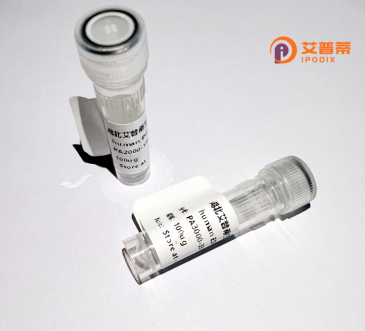
| 纯度 | >90%SDS-PAGE. |
| 种属 | Human |
| 靶点 | BIRC1 |
| Uniprot No | Q13075 |
| 内毒素 | < 0.01EU/μg |
| 表达宿主 | E.coli |
| 表达区间 | 60-345aa |
| 氨基酸序列 | EAKRLKTFVTYEPYSSWIPQEMAAAGFYFTGVKSGIQCFCCSLILFGAGLTRLPIEDHKRFHPDCGFLLNKDVGNIAKYDIRVKNLKSRLRGGKMRYQEEEARLASFRNWPFYVQGISPCVLSEAGFVFTGKQDTVQCFSCGGCLGNWEEGDDPWKEHAKWFPKCEFLRSKKSSEEITQYIQSYKGFVDITGEHFVNSWVQRELPMASAYCNDSIFAYEELRLDSFKDWPRESAVGVAALAKAGLFYTGIKDIVQCFSCGGCLEKWQEGDDPLDDHTRCFPNCPFL |
| 分子量 | 48.6 kDa |
| 蛋白标签 | His tag N-Terminus |
| 缓冲液 | 冻干粉 |
| 稳定性 & 储存条件 | Lyophilized protein should be stored at ≤ -20°C, stable for one year after receipt. Reconstituted protein solution can be stored at 2-8°C for 2-7 days. Aliquots of reconstituted samples are stable at ≤ -20°C for 3 months. |
| 复溶 | Always centrifuge tubes before opening.Do not mix by vortex or pipetting. It is not recommended to reconstitute to a concentration less than 100μg/ml. Dissolve the lyophilized protein in distilled water. Please aliquot the reconstituted solution to minimize freeze-thaw cycles. |
以下是关于重组人BIRC1蛋白的3篇参考文献及其摘要概括:
1. **文献名称**:*Structural basis for NAIP functional specificity in the flagellin inflammasome pathway*
**作者**:Kofoed, E. M., & Vance, R. E.
**摘要**:该研究通过晶体结构分析揭示了BIRC1(NAIP)蛋白识别细菌鞭毛蛋白的分子机制,解释了其作为炎性体传感器在先天免疫中的特异性作用。
2. **文献名称**:*NAIP proteins regulate neutrophil chemotaxis and migration in inflammation*
**作者**:López-Hernández, F. J., et al.
**摘要**:本文发现BIRC1/NAIP通过调控细胞骨架重构影响中性粒细胞趋化功能,提示其在炎症反应中的潜在调控作用。
3. **文献名称**:*The role of NAIP in neuronal apoptosis following spinal cord injury*
**作者**:Hu, J., et al.
**摘要**:研究证明BIRC1在脊髓损伤后通过抑制caspase-9活性减少神经元凋亡,为神经保护治疗提供新靶点。
部分文献可能使用BIRC1的别名NAIP(NLR family apoptosis inhibitory protein)。如需扩展可补充特定领域研究。
**Background of Recombinant Human BIRC1 Protein**
Baculoviral IAP repeat-containing protein 1 (BIRC1), also known as neuronal apoptosis inhibitory protein (NAIP), belongs to the inhibitor of apoptosis (IAP) family. It is characterized by conserved baculoviral IAP repeat (BIR) domains, which mediate anti-apoptotic functions by binding caspases and suppressing their proteolytic activity. Human BIRC1 contains three BIR domains, a NACHT nucleotide-binding domain, and leucine-rich repeats (LRRs), implicating roles in both apoptosis regulation and innate immunity.
BIRC1 inhibits apoptosis by directly obstructing caspase activation, particularly caspase-9 and caspase-3/7. thereby preserving cell survival under stress. Additionally, as a member of the NLR family, it participates in pathogen-sensing pathways. For example, BIRC1 recognizes bacterial components like flagellin, triggering inflammasome assembly and subsequent inflammatory cytokine release (e.g., IL-1β, IL-18).
Mutations in the *BIRC1* gene are linked to spinal muscular atrophy (SMA) and contribute to neurodegenerative or inflammatory disorders. Recombinant BIRC1 protein is utilized to study its molecular interactions, immune signaling mechanisms, and therapeutic potential in diseases involving dysregulated apoptosis or inflammation, such as cancer or infectious diseases. Its dual roles in cell survival and immunity highlight its significance in both basic research and clinical applications.
×